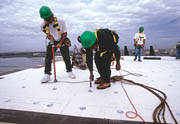The Evolution of Gypsum in Roofing Continues: Georgia-Pacific Dens-Deck

In this day and age, our clients expect us to deliver more in the way of thermal and moisture protection than ever before. They expect roofing systems to last longer while keeping the cost in line. Don’t forget we are also now expected to protect their buildings from fire, hail and all the extremes of wind, sun, snow, smog, chemical attack and even mold. So we are in desperate need of better materials and systems in order to even attempt to deliver on this set of demands.
Most modern materials and systems found on today’s roofing job are new combinations of the basic building blocks that have been used for as many as thousands of years. Clay, concrete, steel, asphalt, gypsum and the expanded world of other polymer-based materials (to name but a few) are not new to roofing. How they are combined to make new and improved materials and systems is what changes
One of these basic materials whose use in construction can be traced back thousands of years is gypsum. You may not think of gypsum as a traditional roofing material, but it has been around for many years in use as a roof deck component. Advancement in the evolution of gypsum in roofing occurred some 15 years ago with the introduction of Georgia-Pacific’s Dens-Deck. Dens-Deck was first intended for a completely different use as a component of the building envelope.
GP calls Dens-Deck a “gypsum roof-protection board” or simply a “roof board.” Don’t know what else you would call it, but given the many attributes it can bring to a roofing system, as you will see, these monikers seem to fall short. At any rate, this article seeks not to delve into technical matters of Dens-Deck as a component roofing material, but to examine its use in roofing and have a look back at its history. How did this product end up in roofing? How have its uses changed? How has the product been enhanced since its introduction? What do building owners, roofing specifiers, manufacturers and contractors think of the product?
In the Beginning
Atlanta-based Georgia-Pacific Corp. traces its entry into the gypsum business back to the purchase of Bestwall Gypsum, which introduced the first fire-rated “X”-type gypsum board, among other innovations. In the 1980s, a new type of exterior insulation and finishing system(EIFS) had arrived from Europe and makers of gypsum wallboard products were delighted to be the backing component of these new systems. The only problem was that paper-faced wallboard could not stand being exposed to the elements for very long. Contractors and specifiers were after a product with the basic characteristics of gypsum wallboard, but one that could be exposed to the elements during often extended construction periods.To meet this challenge, GP developed Dens-Glass, a wallboard product with primed fiberglass facers and a water-resistant treated core. The first test applications were in Maine on condominium projects just yards from the Atlantic Ocean. These tests proved that Dens-Glass could outlast the construction process in a very unforgiving environment, so the new product was introduced to the wider market.
GP representatives began to go around the country telling architects and specifiers about their new and innovative exterior wallboard component for EIFS. In the process, architects instantly recognized an application for the product in low-slope roofing systems due to its substrate qualities: fire resistance, moisture resistance and strength. The use of Dens-Glass as a cover-board came about when architects and roof consultants saw it as the solution to several of their ongoing issues with roofing systems.
It did not take very long for GP to realize that sales of Dens-Glass for roofing applications were running as strong as for the wall application for which it was invented. The original Factory Mutual Research (FM) testing on the product as a roof board came in 1987, and Dens-Deck, a white-faced version of the gold-faced Dens-Glass was born.
Following several years of rapid growth in the sale of Dens-Deck in the basic 1/2-inch and 5/8-inch thickness, GP introduced 1/4-inch Dens-Deck to a very receptive audience. This new, more affordable version of Dens-Deck doubled sales of Dens-Deck from 1993 to 1994. The next innovation in the product came in 2000 when GP rolled out Dens-Deck Prime. This product features a primed facer that is designed specifically to reduce the labor and materials required to install membrane-roofing systems. Installing fully adhered single-ply membranes on Dens-Deck Prime requires less adhesive than with original Dens-Deck or other roof insulation or cover board products. Fewer fasteners are required for Dens-Deck prime as well.
What’s In It for Me?
As reported in the February 2002 issue of Roofing Contractor (“Exclusive Survey of Building Owners Reveals Opportunity for Contractors,” by Dave Harrison, page 44), building owners demand quality in every aspect of the construction process. They want a quality system and quality materials installed by a first-rate roofing contractor. We all know the many challenges building owners and managers face when it comes to their roofing systems. They must be concerned not only with keeping the water out, but maintaining a system that will withstand the variables of their local weather conditions. Going forward in the life of the building, owners must have a system that will also withstand ongoing foot traffic and the occasional building modification that requires cutting through and working on the roof.T Freeman of T.W. Freeman Consultants, Newark, Ohio, worked with GP in some of the FM testing and approvals process. Freeman specifies Dens-Deck as both an underlayment in some situations to achieve fire ratings, and as an overlayment for resistance to fire and because its high compressive strength provides a suitable substrate for roofing membranes. Other attributes Freeman cites are the “zero flame spread, zero smoke developed … (and) high wind-uplift ratings.”
Dick Peterson of Richard Peterson and Associates, Quincy, Mass., looks to Dens-Deck because of its moisture-resistant qualities and particularly because of its compatibility with asphalt and most other adhesives used to apply a wide variety of roofing systems. Peterson thinks roofing contractors should know that Dens-Deck is cost competitive, will withstand the test of time, will save damage to the underlayment in the event of a breach in the primary membrane, and is fireproof.
Roofing contractors have realized many of the benefits to specifying and installing Dens-Deck, and the ranks of contractors using the product even when it is not specified are growing. One roofing contractor working on a warehouse roof in northern Ohio specified 1/4-inch Dens-Deck as a cover board because of the overall cost and several key performance characteristics. The system being installed was a smooth-surfaced, torch-applied modified bitumen system. This particular warehouse was an older vintage with an existing BUR over a low-thermal insulation and a steel deck. The area being roofed was a sizable bay in the center of the building. Of the eight bays, only two were set for re-roof that year.
The two key factors for specifying Dens-Deck were due to the use of the torch and because of the anticipated traffic when the other sections of the roof were to be recovered. With the ease of application and the elimination of some key issues, the roofing contractor figured this was actually the low-cost solution.
This brings up another issue some owners and contractors have: the issue of cost. Dens-Deck Prime was designed in response to requests of contractors and specifiers to come up with a way to use less adhesive and fasteners. On some applications, the higher-priced materials can result in the lower-cost system. Roofing contractors are aces when it comes to value engineering — they simply need to know the characteristics and boundaries of a material to make it fit better into the overall package.
Roofing system manufacturers are on board with Dens-Deck as well. Over 80 roofing manufacturers listed in the FM Approvals Guide list Dens-Deck in one or more of their systems. Sarnafil was one of the first manufacturers to recognize the benefit of having Dens-Deck as a component of its roofing systems. Speaking about Dens-Deck, Sarnafil’s Brian Whelan says, “In general, whenever we can … we recommend it.” He says it “builds a better roof,” which is what Sarnafil strives for. Whelan particularly likes the strength it adds to the system for better resistance to hail, punctures and fire.
Now What?
Dens-Deck is not a “new” product in the conventional sense of the word. In roofing, however, 15 years is not a very long time. With these years of service behind them, GP can now point to a number of success stories, including a major retailer in the Midwest who had a single-ply roof over Dens-Deck on a facility survive a hailstorm without damage to the membrane or the other building components beneath. This was the replacement roof on a building that originally had a single-ply membrane over foam insulation that had been devastated by hail.Roofing contractors are constantly searching for solutions to a wide range of construction issues. While there may be other solutions, when the low-slope roof calls for re-covering, or the owner wants fire protection over an existing combustible deck, or when the roofing contractor knows downstream foot-traffic is going to cause him headaches, or when the homeowner wants wood shakes and must have a fire rating — Dens-Deck is consistently proving itself as the one product that can do it all.
If this product is so great, why doesn’t anyone else offer it? Good question. Dens-Deck is covered under a number of process and product patents. It is expected that others will come along, perhaps soon, with competing products. In the meantime, Dens-Deck is available through a number of roofing systems manufacturers and a nationwide network of roofing products distributors.
As with any product or system on the market, it is recommended that roofing contractors learn all they can about a product before they specify or install it. Learn more about GP Dens-Deck from your local roofing supplier, manufacturer, or any one of GP’s many agents that cover the territory from coast to coast. And when you ask about it, don’t just ask for Dens-Deck or “roof board.” Ask them to tell you about that “Fire-resistant, flexible, compatible, moisture-resistant, impact-resistant roof overlayment/underlayment board.”
Looking for a reprint of this article?
From high-res PDFs to custom plaques, order your copy today!






